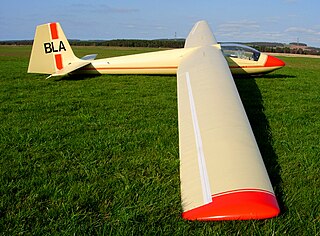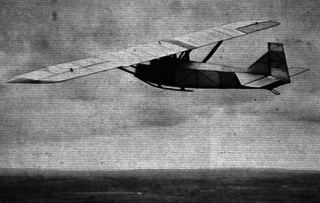Related Research Articles

The Slingsby Type 51 Dart is a single seat competition glider designed in the early 1960s, initially as a 15 m span Standard Class aircraft but evolved into an Open Class, 17 m sailplane. It was the last Slingsby sailplane to be mostly constructed of wood.

The Slingsby T.43 Skylark 3 was a single seat Open Class sailplane developed from the Skylark 2 with an extended wingspan. It won the 1960 World Gliding Championships.

The Slingsby T.50 Skylark 4 was a British single seat competition glider built by Slingsby Sailplanes in the early 1960s. It sold in numbers and had success at national, though not world level competition.

The ESG Grunau 9, later known as the ESG 29 and post-1933 as the DFS 108-10, was one of the first primary gliders, built in Germany from the late 1920s. It was widely sold.
The Addyman Zephyr was a one-off, single-seat sailplane designed and built by Erik Addyman in the UK for his own use in the 1930s.

The Cloudcraft Dickson Primary was a single-seat primary glider designed in the United Kingdom in 1930 to be constructed from plans. Many glider clubs in the UK and the British Empire flew them in the 1930s.
The Czerwiński Sparrow, sometimes known as the de Havilland Canada glider, was a single seat glider, designed and built by a group of de Haviiland engineers in Canada in 1942. It was intended to popularise gliding and be suitable for both basic training and thermal soaring.
The Cramlington Cramcraft was a simple, single-seat, primary training glider, designed and built in the United Kingdom by Cramlington Aircraft Ltd. at Cramlington Aerodrome in 1930. About three were built.
The Dart Cambridge was a single-seat competition sailplane built in the United Kingdom in the 1930s. A development of the Grunau Baby, only two were built, flying with gliding clubs.
The Penrose Pegasus was a 1930s high-wing, single-seat, wooden glider from the UK. Designed, built and flown by Harald Penrose until the start of World War II, only one was built at the time though a reproduction was constructed in the 1990s.
The Radlock Trainer was a single seat primary glider designed and built by members of the Hull Experimental Gliding Club as a basic trainer for their own use in the early 1930s. It was a simple, single exposed seat, wooden glider with a parasol wing.
The Reynard R.4 Primary was an open seat primary glider with an open girder fuselage and a high, wire braced wing. It was designed and built in the UK in 1930 and a few served Gliding Clubs in England and Ireland.
The Teichfuss Allievo Pavullo was an Italian single seat open frame primary glider, designed by Luigi Teichfuss of Pavullo and first flown in 1940. It was sold in two versions, strut and cable braced. A single two seat variant was also built.
The RRG Professor was a very early soaring glider and the first to use a variometer for finding thermals. It was designed by Alexander Lippisch in Germany, first flying in 1928. The Professor was widely built by both flying clubs and factories.

The RRG Falke of 1930 was a secondary training glider designed by Alexander Lippisch in Germany and intended to provide better performance than his earlier RRG Prüfling whilst being easier to fly because of its inherent stability. It was sold as plans for both club and commercial production and was built in Germany and abroad.

The 1926 German RRG Prüfling of 1926 was a secondary training glider designed for club use. Plans were sold and it was built in Germany and across the world.

The Jacobs Hols der Teufel was a single seat trainer glider produced in complete and plan forms in Germany from 1928. It was built and used worldwide.

The Schleicher Poppenhausen named after the town of Poppenhausen was a two-seat glider, available as a dual control advanced trainer, produced in Germany from 1928.
The Schneider ES-54 Gnome was an experimental low cost glider with a laminar flow but low aspect ratio wing, built in Australia in the mid-1950s. Its performance was predictably poor and only one was completed.
The Musger Mg 9 was a tandem two seat glider built in Austria in the mid-1930s. It broke both world and national records.
References
- 1 2 "Imperial College Gliding Club Archives" . Retrieved 24 October 2011.
- 1 2 3 4 "The Incredible" (PDF). Sailplane & Glider. 1 (11): 84. 14 November 1930.
- 1 2 3 4 Ellison, Norman (1971). British Gliders and Sailplanes. London: A & C Black Ltd. p. 151. ISBN 0-7136-1189-8.